3D-Printed Metasurface Units for Potential Energy Harvesting Applications at the 2.4 GHz Frequency Band
Abstract
:1. Introduction
2. Materials and Methods
2.1. Metasurface Fabrication
2.2. Electromagnetic Characterization of the MSs
2.3. Energy Harvesting Verification Experiments
2.4. Theoretical Simulations Details
3. Results and Discussion
3.1. Electromagnetic Response of the FR-4 Built MS
3.2. Verification of Energy Harvesting in FR-4 Built MS
3.3. Verification of Energy Harvesting in Ag/PLA MS
3.4. Verification of energy Harvesting in Electrifi MS
4. Summary
5. Conclusions
Supplementary Materials
Author Contributions
Funding
Data Availability Statement
Conflicts of Interest
References
- Soukoulis, C.M.; Wegener, M. Past achievements and future challenges in the development of three-dimensional photonic metamaterials. Nat. Photonics 2011, 5, 523–530. [Google Scholar] [CrossRef] [Green Version]
- Bukhari, S.S.; Vardaxoglou, J.Y.; Whittow, W. A Metasurfaces Review: Definitions and Applications. Appl. Sci. 2019, 9, 2727. [Google Scholar] [CrossRef] [Green Version]
- Chen, T.; Li, S.; Sun, H. Metamaterials application in sensing. Sensors 2012, 12, 2742–2765. [Google Scholar] [CrossRef]
- Choudhary, Y.S.; Gomathi, N. Advanced Materials for Electromagnetic Shielding Metamaterials as Shielding Materials. In Advanced Materials for Electromagnetic Shielding: Fundamantals, Properties and Appplications; Jaroszewski, M., Thomas, S., Rane, A.V., Eds.; Wiley: Hoboken, NJ, USA, 2018; pp. 367–391. [Google Scholar] [CrossRef]
- Xing, X.; Li, Y.; Lu, Y.; Zhang, W.; Zhang, X.; Han, J.; Zhang, W. Terahertz metamaterial beam splitters based on untraditional coding scheme. Opt. Express 2019, 27, A1627–A1635. [Google Scholar] [CrossRef] [PubMed]
- Tsilipakos, O.; Xomalis, A.; Kenanakis, G.; Farsari, M.; Soukoulis, C.M.; Economou, E.N.; Kafesaki, M. Split-cube-resonator-based metamaterials for polarization-selective asymmetric perfect absorption. Sci. Rep. 2020, 10, 17653. [Google Scholar] [CrossRef] [PubMed]
- Tsilipakos, O.; Zhang, L.; Kafesaki, M.; Soukoulis, C.M.; Koschny, T. Experimental Implementation of Achromatic Multiresonant Metasurface for Broadband Pulse Delay. ACS Photonics 2021, 8, 1649–1655. [Google Scholar] [CrossRef]
- Chen, Z.; Guo, B.; Yang, Y.; Cheng, C. Metamaterials-based enhanced energy harvesting: A review. Phys. B Condens. Matter 2014, 438, 1–8. [Google Scholar] [CrossRef]
- Shaikh, F.K.; Zeadally, S. Energy harvesting in wireless sensor networks: A comprehensive review. Renew. Sustain. Energy Rev. 2016, 55, 1041–1054. [Google Scholar] [CrossRef]
- Tan, T.; Yan, Z.; Zou, H.; Ma, K.; Liu, F.; Zhao, L.; Peng, Z.; Zhang, W. Renewable energy harvesting and absorbing via multi-scale metamaterial systems for Internet of things. Appl. Energy 2019, 254, 113717. [Google Scholar] [CrossRef]
- Ramahi, O.M.; Almoneef, T.S.; AlShareef, M.; Boybay, M.S. Metamaterial particles for electromagnetic energy harvesting. Appl. Phys. Lett. 2012, 101, 173903. [Google Scholar] [CrossRef] [Green Version]
- Hawkes, A.M.; Katko, A.R.; Cummer, S.A. A microwave metamaterial with integrated power harvesting functionality. Appl. Phys. Lett. 2013, 103, 163901. [Google Scholar] [CrossRef] [Green Version]
- El Badawe, M.; Almoneef, T.S.; Ramahi, O.M. A metasurface for conversion of electromagnetic radiation to DC. AIP Adv. 2017, 7, 35112. [Google Scholar] [CrossRef] [Green Version]
- Duan, X.; Chen, X.; Zhou, L. A metamaterial electromagnetic energy rectifying surface with high harvesting efficiency. AIP Adv. 2016, 6, 125020. [Google Scholar] [CrossRef]
- Almoneef, T.S.; Ramahi, O.M. Metamaterial electromagnetic energy harvester with near unity efficiency. Appl. Phys. Lett. 2015, 106, 153902. [Google Scholar] [CrossRef]
- Almoneef, T.S.; Erkmen, F.; Ramahi, O.M. Harvesting the Energy of Multi-Polarized Electromagnetic Waves. Sci. Rep. 2017, 7, 14656. [Google Scholar] [CrossRef] [PubMed] [Green Version]
- Aldhaeebi, M.A.; Almoneef, T.S. Planar Dual Polarized Metasurface Array for Microwave Energy Harvesting. Electronics 2020, 9, 1985. [Google Scholar] [CrossRef]
- Oumbé Tékam, G.T.; Ginis, V.; Danckaert, J.; Tassin, P. Designing an efficient rectifying cut-wire metasurface for electromagnetic energy harvesting. Appl. Phys. Lett. 2017, 110, 83901. [Google Scholar] [CrossRef] [Green Version]
- Erkmen, F.; Ramahi, O.M. A Scalable, Dual-Polarized Absorber Surface for Electromagnetic Energy Harvesting and Wireless Power Transfer. IEEE Trans. Microw. Theory Tech. 2021, 69, 4021–4028. [Google Scholar] [CrossRef]
- Ashoor, A.Z.; Ramahi, O.M. Polarization-Independent Cross-Dipole Energy Harvesting Surface. IEEE Trans. Microw. Theory Tech. 2019, 67, 1130–1137. [Google Scholar] [CrossRef]
- Nowak, M. Metamaterial-Based Sub-Microwave Electromagnetic Field Energy Harvesting System. Energies 2021, 14, 3370. [Google Scholar] [CrossRef]
- Wagih, M.; Weddell, A.S.; Beeby, S. Rectennas for Radio-Frequency Energy Harvesting and Wireless Power Transfer: A Review of Antenna Design [Antenna Applications Corner]. IEEE Antennas Propag. Mag. 2020, 62, 95–107. [Google Scholar] [CrossRef]
- Shahrubudin, N.; Lee, T.C.; Ramlan, R. An Overview on 3D Printing Technology: Technological, Materials, and Applications. Procedia Manuf. 2019, 35, 1286–1296. [Google Scholar] [CrossRef]
- Ngo, T.D.; Kashani, A.; Imbalzano, G.; Nguyen, K.T.Q.; Hui, D. Additive manufacturing (3D printing): A review of materials, methods, applications and challenges. Compos. Part B Eng. 2018, 143, 172–196. [Google Scholar] [CrossRef]
- Vallecchi, A.; Cadman, D.; Whittow, W.G.; Vardaxoglou, J.; Shamonina, E.; Stevens, C.J. 3-D Printed Bandpass Filters with Coupled Vertically Extruded Split Ring Resonators. IEEE Trans. Microw. Theory Tech. 2019, 67, 4341–4352. [Google Scholar] [CrossRef] [Green Version]
- Salim, A.; Ghosh, S.; Lim, S. Low-Cost and Lightweight 3D-Printed Split-Ring Resonator for Chemical Sensing Applications. Sensors 2018, 18, 3049. [Google Scholar] [CrossRef] [PubMed] [Green Version]
- Tasolamprou, A.C.; Mentzaki, D.; Viskadourakis, Z.; Economou, E.N.; Kafesaki, M.; Kenanakis, G. Flexible 3D Printed Conductive Metamaterial Units for Electromagnetic Applications in Microwaves. Materials 2020, 13, 3879. [Google Scholar] [CrossRef]
- Pizarro, F.; Salazar, R.; Rajo-Iglesias, E.; Rodríguez, M.; Fingerhuth, S.; Hermosilla, G. Parametric Study of 3D Additive Printing Parameters Using Conductive Filaments on Microwave Topologies. IEEE Access 2019, 7, 106814–106823. [Google Scholar] [CrossRef]
- Ishikawa, A.; Kato, T.; Takeyasu, N.; Fujimori, K.; Tsuruta, K. Selective electroless plating of 3D-printed plastic structures for three-dimensional microwave metamaterials. Appl. Phys. Lett. 2017, 111, 183102. [Google Scholar] [CrossRef]
- Kenanakis, G.; Vasilopoulos, K.C.; Viskadourakis, Z.; Barkoula, N.-M.; Anastasiadis, S.H.; Kafesaki, M.; Economou, E.N.; Soukoulis, C.M. Electromagnetic shielding effectiveness and mechanical properties of graphite-based polymeric films. Appl. Phys. A 2016, 122, 802. [Google Scholar] [CrossRef]
- Mousa Ali, E.; Yahaya, N.Z.; Nallagownden, P.; Zakariya, M.A. A novel rectifying circuit for microwave power harvesting system. Int. J. RF Microw. Comput. Eng. 2017, 27, e21083. [Google Scholar] [CrossRef]
- Wang, D.; Negra, R. Design of a rectifier for 2.45 GHz wireless power transmission. In Proceedings of the PRIME 2012 8th Conference on Ph.D. Research in Microelectronics & Electronics, Aachen, Germany, 12–15 June 2012; pp. 1–4. [Google Scholar]
- Wang, R.; Ye, D.; Dong, S.; Peng, Z.; Salamin, Y.; Shen, F.; Huangfu, J.; Li, C.; Ran, L. Optimal Matched Rectifying Surface for Space Solar Power Satellite Applications. IEEE Trans. Microw. Theory Tech. 2014, 62, 1080–1089. [Google Scholar] [CrossRef]
- Ghaderi, B.; Nayyeri, V.; Soleimani, M.; Ramahi, O.M. Pixelated Metasurface for Dual-Band and Multi-Polarization Electromagnetic Energy Harvesting. Sci. Rep. 2018, 8, 13227. [Google Scholar] [CrossRef] [PubMed]
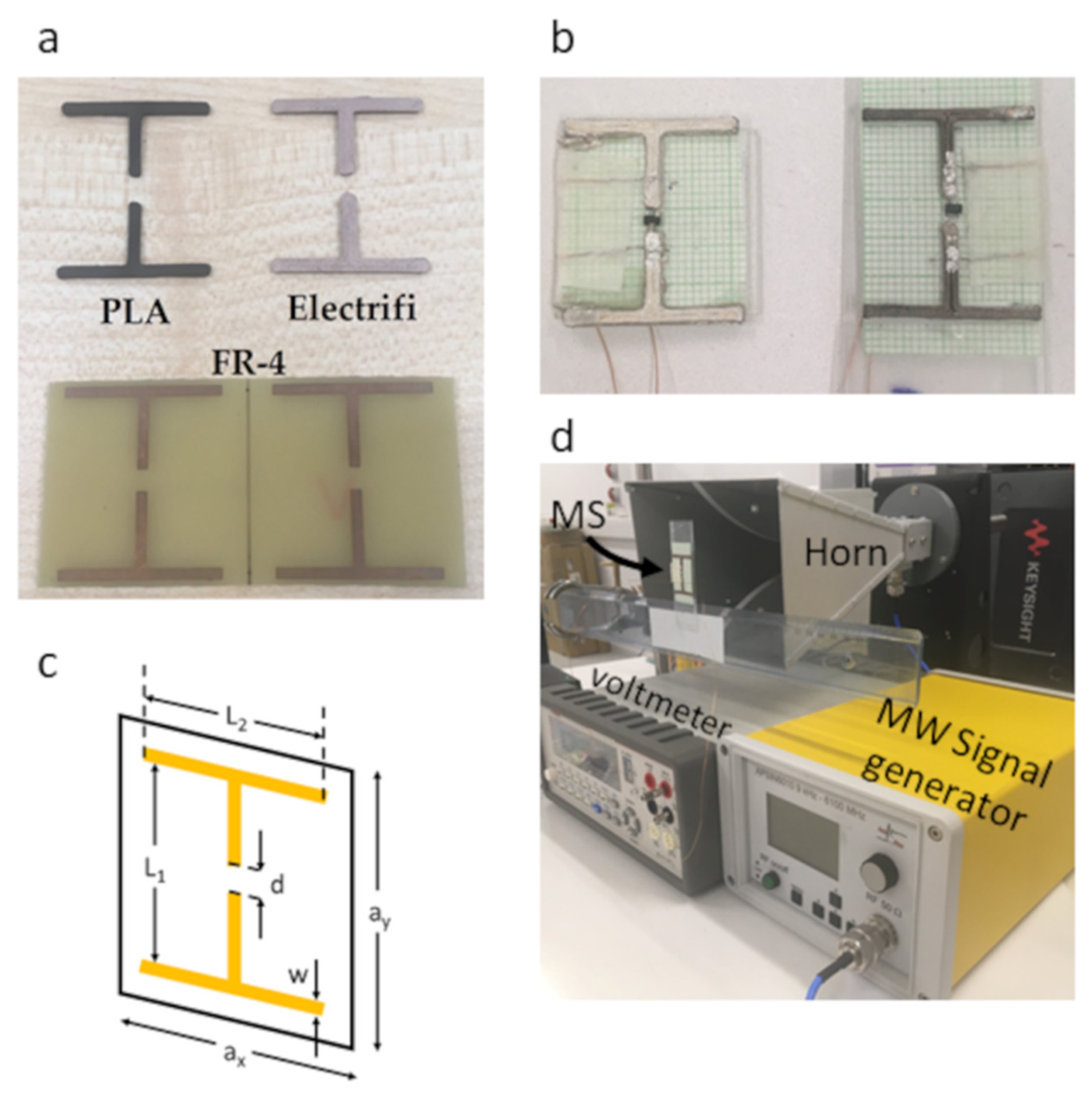
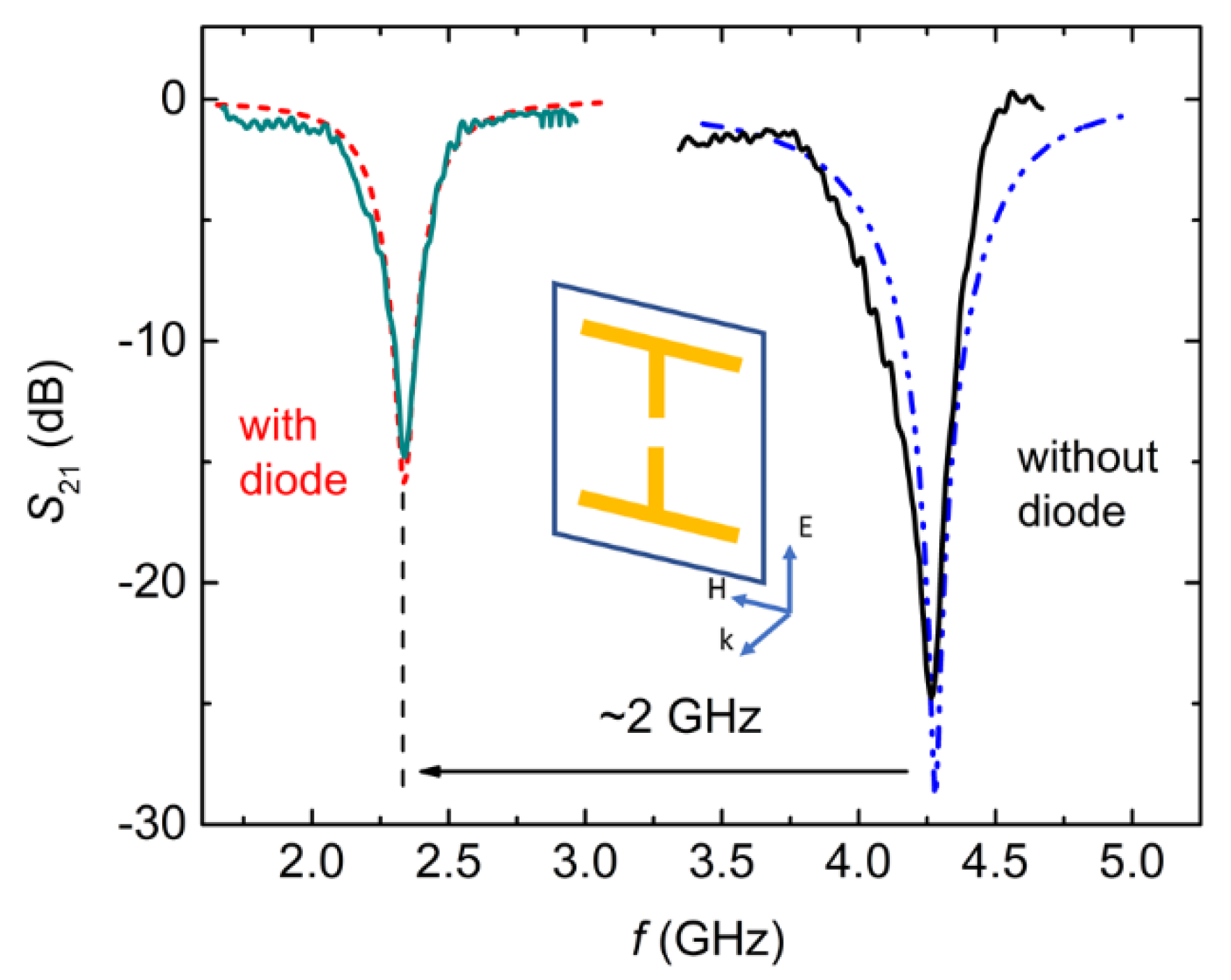
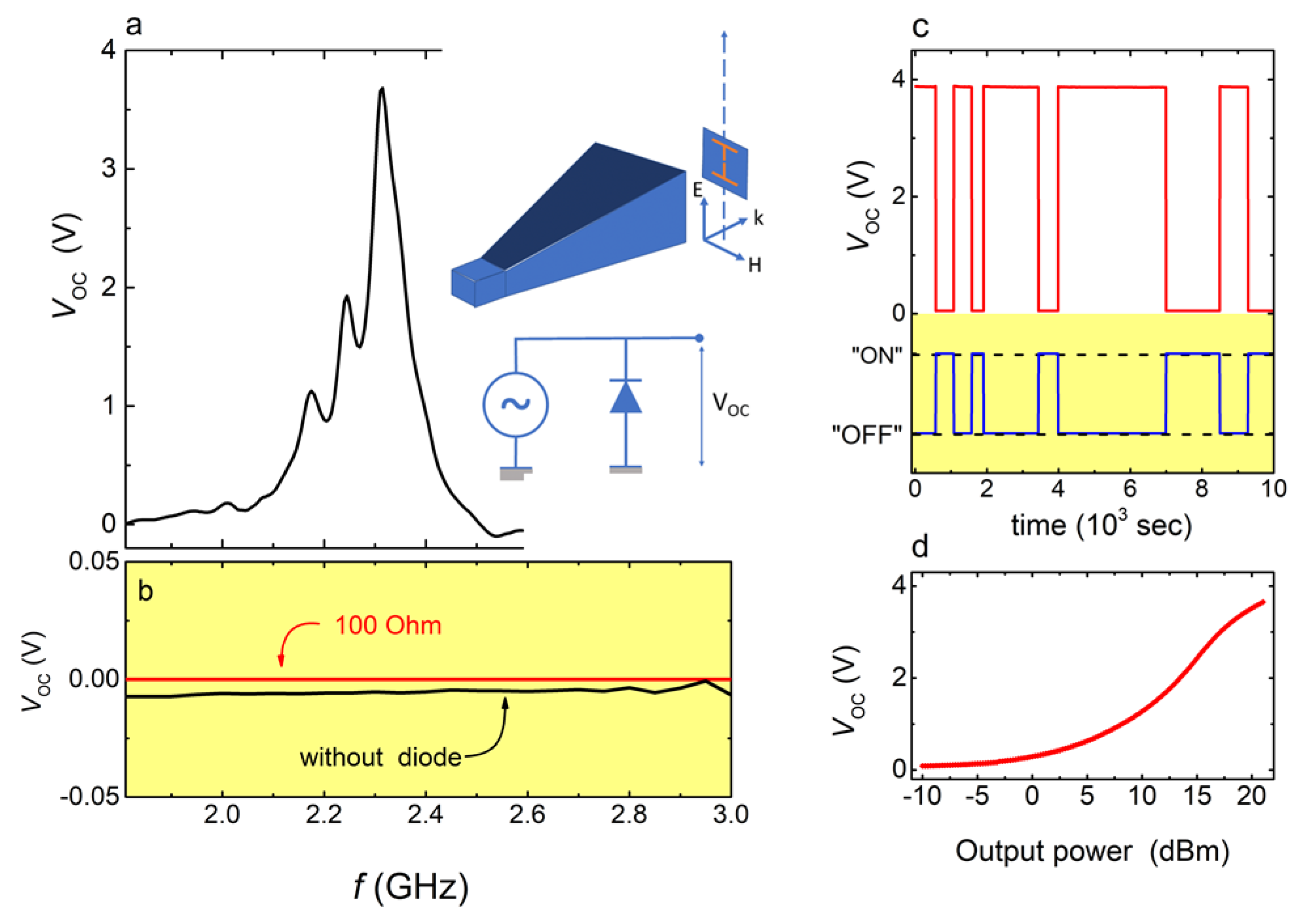
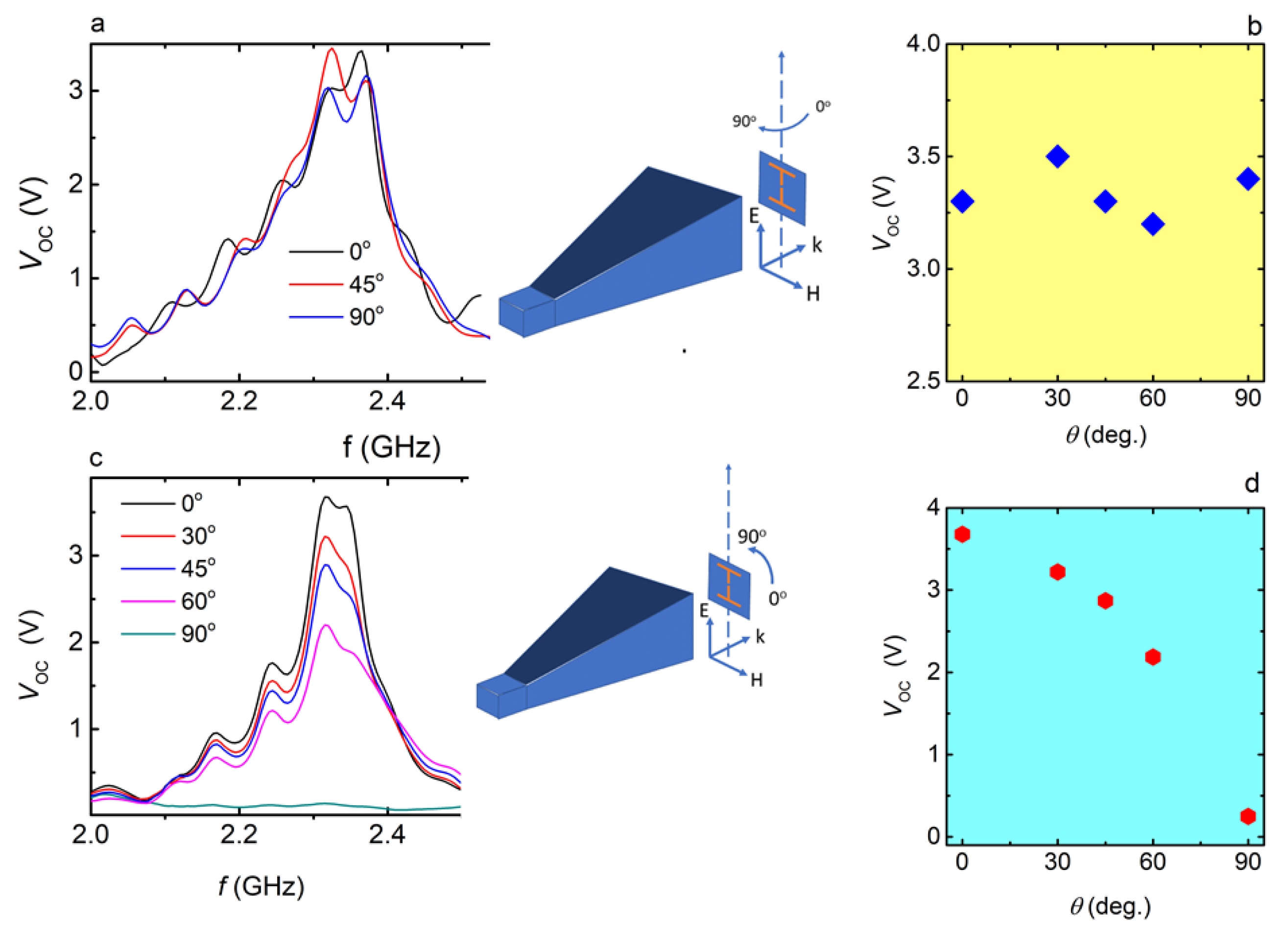
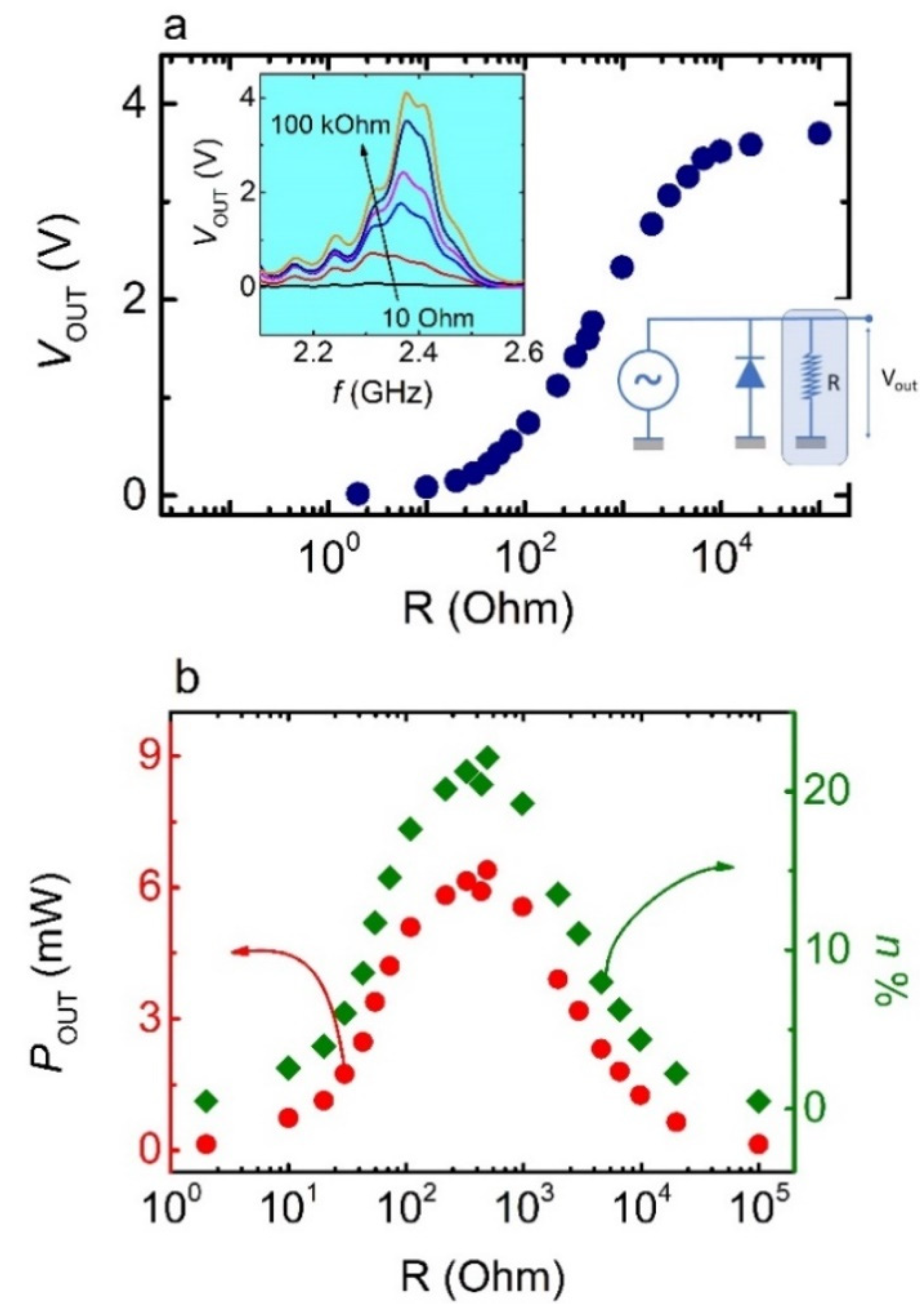
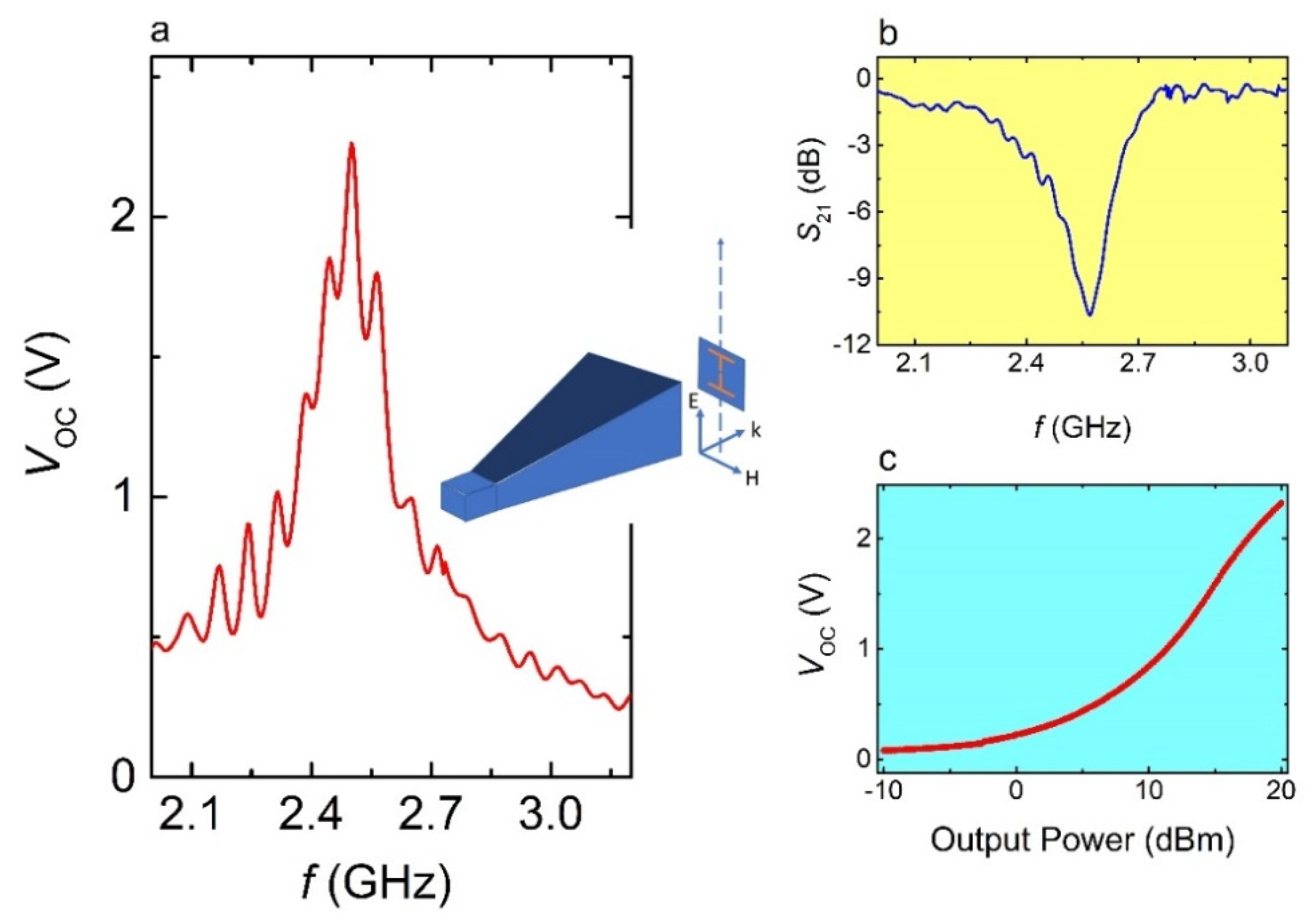

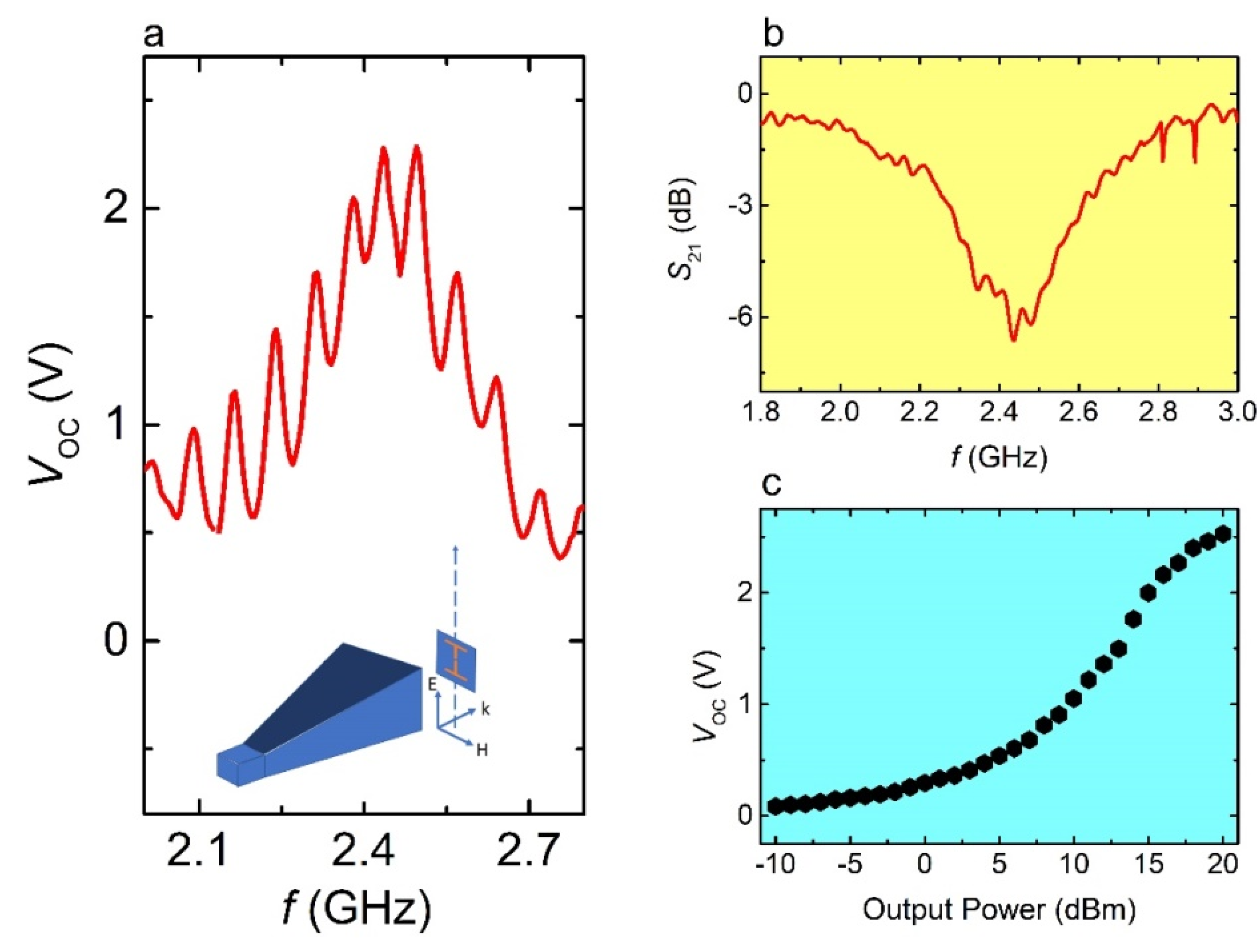
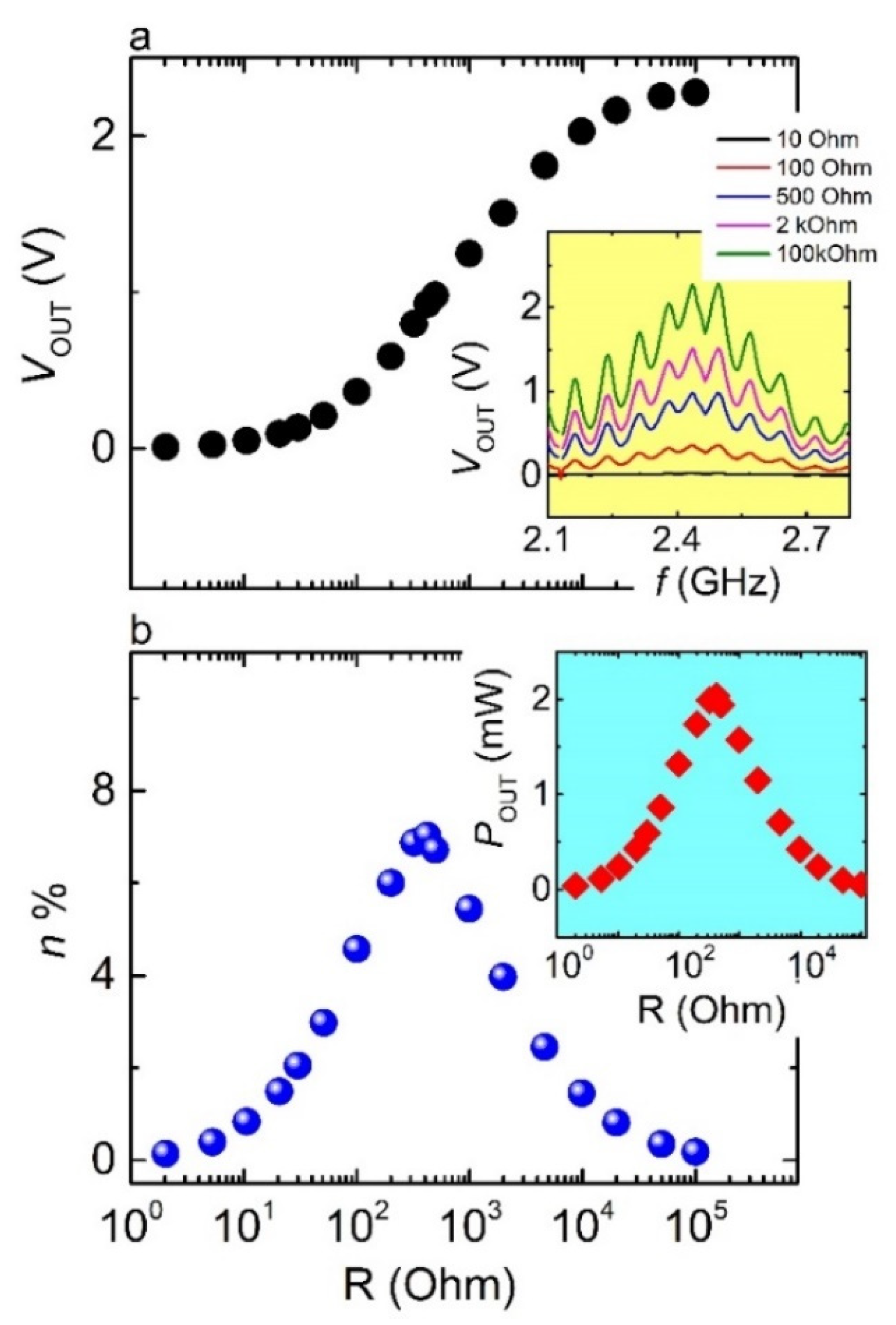
| Dimension | Value (mm) |
|---|---|
| ax, ay | 30.0 |
| L1 | 23.1 |
| L2 | 22.8 |
| w | 1.6 |
| d | 3.0 |
Publisher’s Note: MDPI stays neutral with regard to jurisdictional claims in published maps and institutional affiliations. |
© 2021 by the authors. Licensee MDPI, Basel, Switzerland. This article is an open access article distributed under the terms and conditions of the Creative Commons Attribution (CC BY) license (https://creativecommons.org/licenses/by/4.0/).
Share and Cite
Viskadourakis, Z.; Tamiolakis, E.; Tsilipakos, O.; Tasolamprou, A.C.; Economou, E.N.; Kenanakis, G. 3D-Printed Metasurface Units for Potential Energy Harvesting Applications at the 2.4 GHz Frequency Band. Crystals 2021, 11, 1089. https://doi.org/10.3390/cryst11091089
Viskadourakis Z, Tamiolakis E, Tsilipakos O, Tasolamprou AC, Economou EN, Kenanakis G. 3D-Printed Metasurface Units for Potential Energy Harvesting Applications at the 2.4 GHz Frequency Band. Crystals. 2021; 11(9):1089. https://doi.org/10.3390/cryst11091089
Chicago/Turabian StyleViskadourakis, Z., E. Tamiolakis, O. Tsilipakos, A. C. Tasolamprou, E. N. Economou, and G. Kenanakis. 2021. "3D-Printed Metasurface Units for Potential Energy Harvesting Applications at the 2.4 GHz Frequency Band" Crystals 11, no. 9: 1089. https://doi.org/10.3390/cryst11091089
APA StyleViskadourakis, Z., Tamiolakis, E., Tsilipakos, O., Tasolamprou, A. C., Economou, E. N., & Kenanakis, G. (2021). 3D-Printed Metasurface Units for Potential Energy Harvesting Applications at the 2.4 GHz Frequency Band. Crystals, 11(9), 1089. https://doi.org/10.3390/cryst11091089










